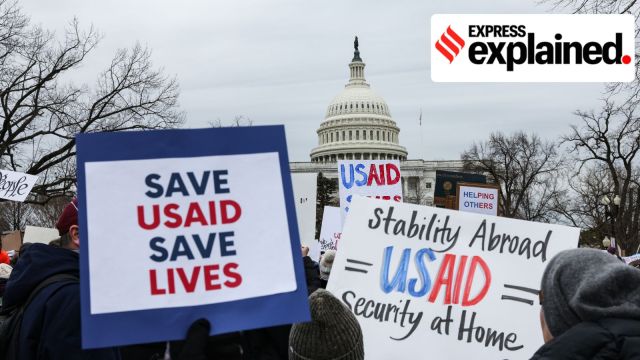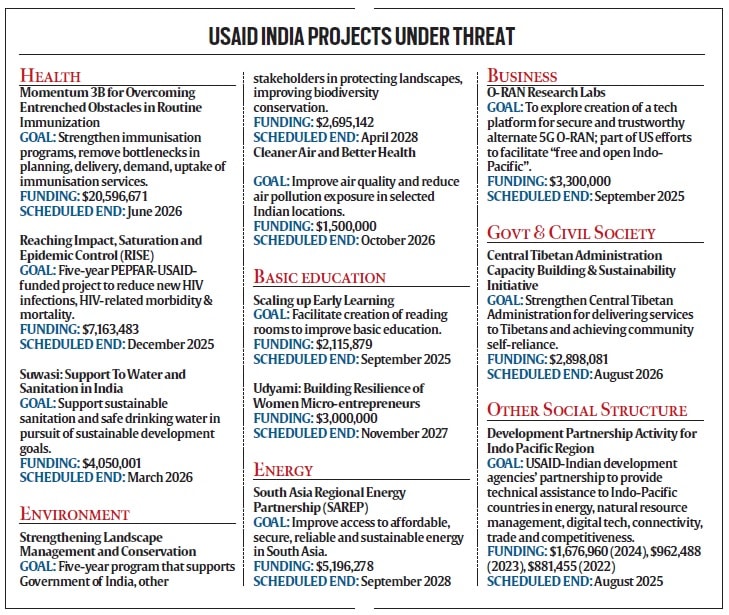What USAID gives in India, to whom
USAID has been a major contributor to health- and population-linked projects in India over the last two decades. In recent years, it has also focussed on building systems in India as part of a partnership strategy drawn up in 2022 to counter China in the Indo-Pacific.
 Current and former USAID employees and supporters rally against the Trump’s administration’s stop-work order on Capitol Hill on Feb. 5, 2025. (NYT)
Current and former USAID employees and supporters rally against the Trump’s administration’s stop-work order on Capitol Hill on Feb. 5, 2025. (NYT)A program to explore the creation of a secure 5G Open Radio Access Network (O-RAN) for India as part of the United States’ Indo-Pacific strategy, initiatives for clean air and water and sanitation, and dozens of health projects will come to a halt in India following a decision by the Trump administration (January 20 Executive Order titled “Reevaluating and Realigning United States Foreign Aid”) to end foreign aid and all but disband the US Agency for International Development (USAID).
USAID has been a major contributor to health- and population-linked projects in India over the last two decades. In recent years, it has also focussed on building systems in India as part of a partnership strategy drawn up in 2022 to counter China in the Indo-Pacific.
In 2022, USAID was fourth among providers of Official Development Assistance to India with a contribution of $228 million after Japan ($2.97 billion), European Union institutions ($383.5 mn) and Germany ($235 mn), according to Organization for Economic Cooperation and Development (OECD) data.
USAID funding for India
Data on foreignassistance.gov, a joint website of USAID and the US Department of State that details US non-defence foreign assistance through governments and NGOs, show USAID disbursed a total $2.8 billion in Official Development Assistance to India since 2001.
The largest aid packets came over 2022 and 2023 – $228 million and $175 million respectively. In 2024, $151 million had been disbursed to India until December 19, when the site was last updated.
A significant increase in USAID allocation to an economic support fund to India after the Covid-19 pandemic – $148 million in 2022 and $81 million in 2023 – was the main reason US aid to India reached all-time highs over the last three years.
These years were the first since the 2001-08 period when total annual disbursals to India exceeded $100 million. (The earlier peak of $175 million was reached in 2006.)
While the bulk of the annual USAID funding in 2001 and 2002 went to Food Aid and Commodity Assistance, the subsequent years saw a focus on the Health and Population category through allocations for polio eradication, maternal health, HIV/ AIDS and tuberculosis control programs – and Covid-19 in the 2022-2024 period.
USAID funding to India over last 3 years
 USAID India projects under threat
USAID India projects under threat
2024: $80 million of the $151 million disbursed to India by USAID in 2024 went to the Health and Population category – with $42.99 million for basic health programs, including $16 million for Covid-19.
The next highest allocation was to maternal and child health and family planning ($20.94 million), followed by environmental protection programs ($17.12 million).
2023: Of the $175 million disbursed by USAID to India in 2023, Health and Population got $120 million, with $83.22 million for basic health (including $54 million for Covid-19 control.
Maternal and child health got $16.28 million, HIV/ AIDS $12.13 million, and environmental protection $9.62 million.
2022: $180 million of the $228 million disbursed by USAID was for the Health and Population category, including $140.7 million for basic health ($120 million was for Covid-19 control).
$25.09 million was given for maternal and child health, $10.57 million for HIV/ AIDS, and $7.18 million for environment protection.
When funds tap shuts
In its effort to stop the US economy from haemorrhaging resources amid growing debt, the Trump administration has gone after USAID and its funding initiatives with a sledgehammer. The impact will be felt in underdeveloped and developing countries in Asia and Africa, including India – especially in those health and social sector areas in which Indian government funding is limited.
TUBERCULOSIS: Breaking the Barriers, a program to increase knowledge about TB in the poorest regions of Karnataka, Telangana, Bihar, and Assam will be a key USAID-funded project that will be hit. Over the 2022-23 period, USAID provided $7 million to the program, routed through the Karnataka Health Promotion Trust (KHPT).
“The program will be closing down. Had the funding continued, there would have been a lot of innovations – but that is going to stop,” a senior official of KHPT, the implementing agency in Karnataka, said.
HIV/AIDS: USAID and PEPFAR (President’s Emergency Plan for AIDS Relief) have been the major contributors to the global fight against HIV/ AIDS.
“[The mission] is currently under threat because of the Trump administration disbanding and abandoning USAID. We are unclear what will happen but the disruption that has already taken place will manifest itself in lives lost and prevention of onward transmission of HIV infections,” the German population health researcher Dr Till Barnighausen told The Indian Express during a visit to Bengaluru recently.
“The major player here globally has been the US via PEPFAR and through global initiatives. With the US potentially moving out the programs will need to be very well managed in order not to cause major long term losses of life,” Dr Barnighausen said.
The German Consul General in Bengaluru Achim Burkart said at a recent public lecture that the cutting of USAID funds “means losing lives”. In Zambia alone, 150,000 people are in desperate need of HIV medication, in the absence of which they will die, Burkart said.
“We the rich countries have a responsibility to support the countries that are not able to support themselves. With at least 50% of the world’s population having no access to safe, affordable, and timely healthcare services, delivering healthcare remains an urgent task,” he said.
On February 13, a US Federal Court stayed the January 20 executive order to halt all foreign aid. The Trump administration appealed to the US Supreme Court and argued that 5,800 foreign aid awards had been evaluated and 500 had been retained. In a 5-4 verdict on March 5, the court rejected the US government’s request to cancel the February 13 order of the US Federal Court.
- 01
- 02
- 03
- 04
- 05






































